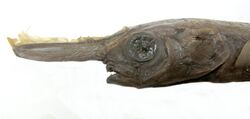Biology:Eumecichthys
| Unicorn crestfish | |
|---|---|

| |

| |
| Eumecichthys fiski, conventional and X-ray images | |
| Scientific classification | |
| Domain: | Eukaryota |
| Kingdom: | Animalia |
| Phylum: | Chordata |
| Class: | Actinopterygii |
| Order: | Lampriformes |
| Family: | Lophotidae |
| Genus: | Eumecichthys Regan, 1907 |
| Species: | E. fiski
|
| Binomial name | |
| Eumecichthys fiski (Günther, 1890)
| |
| Synonyms | |
|
Lophotes fiski Günther, 1890 | |
Eumecichthys fiski, the unicorn crestfish or unicornfish, is a very rare, little-known species of crestfish in the family Lophotidae, and the only member of the genus Eumecichthys. It likely has a worldwide distribution, having been first discovered offshore of Kalk Bay, South Africa , and subsequently reported from the Sea of Japan, southwest Florida, Clarion Island off Mexico, Hawaii, and India . A report from the Bering Sea may have been in error. It is found in the bathypelagic zone, at a depth of around 1,000 m (3,300 ft).[2][3]
This fish has ribbon-like body measuring up to 150 cm (59 in) in length.[2] Its common name comes from a horn-like supraoccipital process projecting forward of its eyes.[4] The upper jaw is protrusible, and the jaws contain small conical teeth.[5] The dorsal fin runs along the entire length of the body and contains 310-392 soft rays; the first three to five dorsal rays at the tip of the projecting ridge are elongated into a pennant. The pectoral fins contain 13-15 rays; the pelvic fins are absent. The anal fin contains five to 9 rays and in adults is split lengthwise to form two rows of nubbins. The caudal fin contains 12-13 rays, with the bottommost ray enlarged and bony. The coloration is silvery with 24-60 dark subvertical bands. The dorsal and caudal fins are crimson.[6]
Eumenichthys is one of three lampriform genera known to possess ink tubes, allowing them to expel a black fluid from their cloacae as a defense against predators. The ink tube is derived from a primitive gut and runs above and parallel to the intestine.[3] A known predator of the unicorn crestfish is the longnose lancetfish (Alepisaurus ferox); a lancetfish 73 cm (29 in) long has been found that had swallowed a unicorn crestfish 55 cm (22 in) long.[7]
References
- ↑ Knudsen, S. (2015). Eumecichthys fiski. The IUCN Red List of Threatened Species doi:10.2305/IUCN.UK.2015-4.RLTS.T190107A60791470.en
- ↑ 2.0 2.1 Froese, Rainer and Pauly, Daniel, eds. (2009). "Eumecichthys fiski" in FishBase. March 2009 version.
- ↑ 3.0 3.1 Honma, Yoshiharu; Ushiki, Tatsuo; Takeda, Masaei (Feb 1999). "Histology of the ink tube and its associated organs in a unicornfish, Eumecichthys fiskii (Lampridiformes)". Ichthyological Research 46 (1): 19–25. doi:10.1007/BF02674944.
- ↑ Richards, W.J. (2006). Early stages of Atlantic fishes: an identification guide for the western central North Atlantic. CRC Press. ISBN 9780849319167.
- ↑ Olney, J.E. (1998). "Lophotidae". in Carpenter, K.E.. FAO species identification guide for fishery purposes. The living marine resources of the Western Central Pacific. Food and Agricultural Organization of the United Nations. ISBN 92-5-104302-7.
- ↑ Smith, J.L.B.; Smith, M.M.; Heemstra, P. (2003). Smiths' Sea Fishes. Struik. ISBN 1-86872-890-0.
- ↑ Fujita, K.; Hattori, J. (1976). "Stomach Content Analysis of Longnose Lancetfish, Alepisaurus ferox in the Eastern Indian Ocean and the Coral Sea". Japanese Journal of Ichthyology 23 (3): 133–142. doi:10.11369/jji1950.23.133.
Wikidata ☰ Q137988 entry
 |



